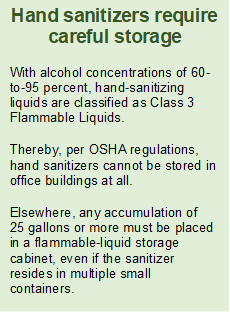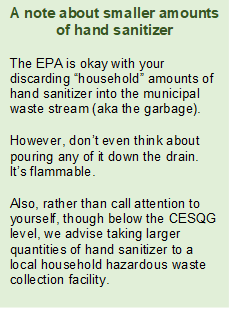Hazardous Waste – Disposal of Hand Sanitizer
February 22, 2022
*Updated February 22, 2022
Since Spring 2020, COVID has induced many businesses and organizations to stock up on hand sanitizer in prodigious amounts. And given the nation’s acute supply-chain woes, they typically play it safe, buying more than they’re probably going to use. But like milk, pretzels, and mayonnaise, hand sanitizer has an expiration date—albeit longer into the future.
Hand sanitizers are mostly alcohol
Most hand-sanitizing liquids & gels are 60-to-95 percent ethyl or isopropyl alcohol. Alcohol is prone to evaporation. (It boils at about 1800 F compared to water  at 2120 F.) So over time, hand sanitizers lose their potency and are largely useless at killing bacteria, which means there might be a hazmat crisis looming next to the faucets in your washrooms. How so?
at 2120 F.) So over time, hand sanitizers lose their potency and are largely useless at killing bacteria, which means there might be a hazmat crisis looming next to the faucets in your washrooms. How so?
Expired hand sanitizer requires hazardous waste disposal
Commercial or industrial amounts of hand sanitizer—at the SQG, LQG, or CESQG levels—require hazardous waste disposal. This is for the usual environmental reasons & rules. But also submitted for your consideration:
If you pour 50 or so gallons of alcohol-based sanitizer down the drain, once vaporized, it’s enough to blow the municipal sewer system’s manhole covers up & away.
Your neighbors will not be amused. The local press will have a field day. Such an event will garner a lot of disquieting attention from federal, state, and local authorities. And seven-digit fines are the norm—not the exception.
Alternatives to hazardous waste management of unwanted or unused hand sanitizers
Proper disposal of unwanted hand sanitizer can be achieved with traditional hazardous waste disposal methods, which require RCRA registration, labeling, manifesting, and reporting. However, traditional hazardous waste disposal is not the only option. There are other options sanctioned by the EPA.
- Fuel blending. The purposeful mixing of different waste streams to induce specific chemical reactions is a recognized treatment method for hazardous waste. This is called fuel blending, wherein such chemical reactions might be instigated to neutralize the hazardous waste material.
Typically, this is done to make the waste less dangerous and thereby easier to store, transport, and ultimately dispose of. But in the case of unwanted hand sanitizer, fuel blending is a way to recover the constituent alcohol and transform it into an energy source that can be used or sold.
- Incidental reduction. This refers to the situation wherein you combine waste streams with no intention of creating a specific chemical reaction, but the resulting mixture no longer exhibits the same physical or chemical characteristics as did the individual wastes prior to your mixing them.
In such a situation, the resulting waste will still need to be treated for the individual wastes that were consolidated—even if a chemical analysis proves that one or more waste characteristics have been eliminated in the consolidation process.
Unfortunately, neither fuel blending nor incidental reduction is specifically defined in EPA rules. Requirements vary by state and localities. (In general, fuel blending requires a hazardous waste installation and operation permit for storage and treatment).
The case for recycling unwanted hand sanitizers
Recycling of hand sanitizers can be more cost-effective than waste disposal, as recycling doesn’t require registering the sanitizer as a hazardous waste. However, there are environmental regulations about transportation and treatment that must be observed. So as in all things regarding the EPA and the DOT, it’s crucial to get expert advice.
there are environmental regulations about transportation and treatment that must be observed. So as in all things regarding the EPA and the DOT, it’s crucial to get expert advice.
The upshot
Our country’s awash in hand sanitizer. Plenty of it is getting used. But a lot of it will need to be disposed of. There’s simply too much of it, and many people eschew using it in the first place, given their eco-predilections and misconceptions. Therein lies the crunch.
Per the OSHA and the EPA, as well as many state and local bureaucracies, sanitizers are considered a potential hazard and hazardous waste, chiefly for their ignitability. And in almost all cases, it’s a state agency that provides enforcement and interpretation of EPA hazmat regulations—not the federal government.
Individual states differ about what constitutes a hazardous waste and how it should be handled. The same can be said about the rules & regulations for recycling. And running afoul of such local dictates can be expensive, litigious, and time-consuming.
Expert advice is crucial. You can get some here.
And thank you for reading our blog!

